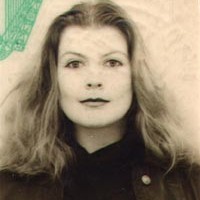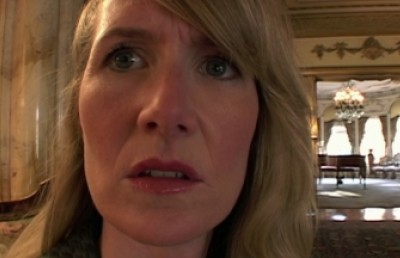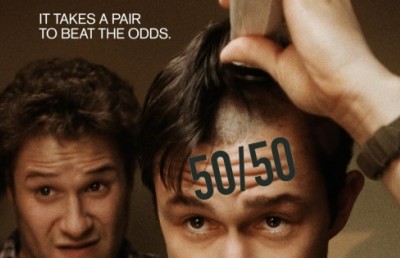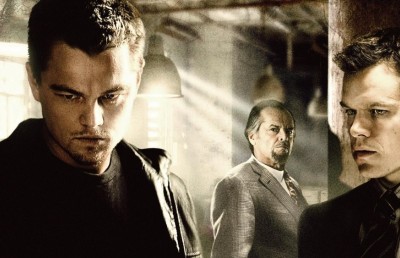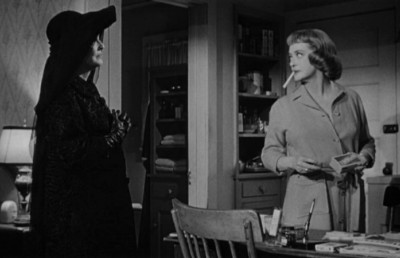Peccadillo and Taboo in Piccadilly (1929)
The Entrancing 'otherness' of Anna May Wong
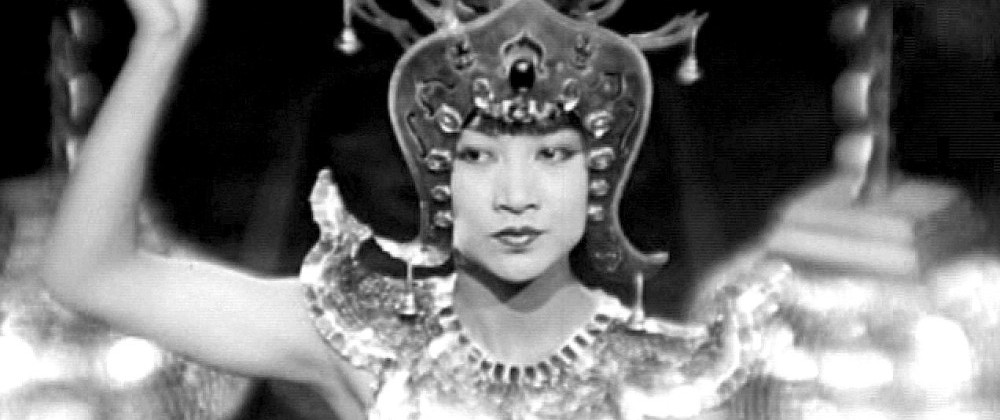
Released by British International Pictures in 1929, Piccadilly remains an unsung hero of early British cinema and its restoration in 2004 returned it to its rightful place in film history: an iconic piece of filmmaking from the late silent era, a triumph of cinema and spectacle boasting a great performance from legendary Chinese-American actress Anna May Wong and a masterful piece of directing by E.A. Dupont working from a screenplay by the novelist Arnold Bennett, best remembered today for his Potteries novels. BIP is probably best known now for its association with Alfred Hitchcock’s early career, especially Blackmail (1929), the first British talking picture. The company had been founded in 1927 by John Maxwell, a Scottish solicitor who acquired British National Studios and Elstree Studios and amalgamated them with his interest in ABC Cinemas. Ten years later after the purchase of Pathé, it would become Associated British Picture Corporation, in an optimistic challenge to American companies’ dominance of production, distribution and exhibition.
Analysis of British cinema has frequently strained to explain why some films are more artistically successful by reference to production contexts which are usually a triumph of financing against difficult local conditions with the actual content, screenplay, artistry or form somehow relegated to the back seat. The industry in the 1920s was suffering at American dominance in the marketplace: by the middle of the decade British cinema’s previous position in exhibition was down to less than 5%. The Cinematograph Act (1927) intended that financing was simplified and stimulated and the consolidating of BIP was intended to take advantage of the legislation with the concept of international film production and distribution as its primary motive. This was the streamlined idea of filmmaking so familiar from the Hollywood model, which itself had a production arm in Germany where Berlin was now the centre of some of Paramount and Metro’s activities under the Parufamet agreement, a loan arrangement which guaranteed Ufa’s survival. With Dupont at the helm and Arnold Bennett hired to write an original work for the screen, Piccadilly was clearly constructed as a prestige production, a major work that would lure not only local but international audiences. Piccadilly proved a rarefied and happy exception in these optimistic days because in order to satisfy the Act’s quota initiative many low-budget quickies filled theatres, helping to give British cinema a bad name. The introduction of sound technology shortly afterwards would put increased pressure on studios to satisfy demand and increase already limited investment funds.
German cinema was hugely influential in Britain at the time, with Hitchcock’s The Lodger (1926) demonstrating its international impact in terms of directorial style. Piccadilly was not properly credited to him during his lifetime, but it was directed by E.A. (Ewald André) Dupont, the German stylist probably best known for Variety (1925), shot with an ‘unfastened camera’ by the luminous Expressionist Karl Freund; and whose most recent work had been Moulin Rouge (1928), made for BIP the previous year. Both films also belong to the category of backstage drama, revenge-filled melos of moodiness and over-acting which Dupont might be said to be reworking here somewhat, albeit with considerable verve. The director had started his career in journalism and progressed from there to writing for the screen, specialising in crime stories. An almost forgotten figure today, his work stands as some of the most exciting, erotic and taboo-strewn on film and deserves reappraisal.
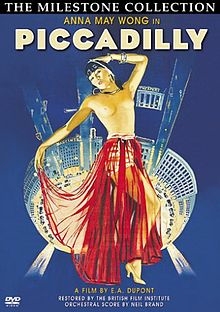
Working from the first screenplay by Bennett, it is the story of the eponymous nightclub where Victor Miles (Cyril Richard) and Mabel (Gilda Gray) are the star dancing attractions although it is evidently Victor who is the performer, as the title cards inform us “They’re the talk of the town” – “Or rather, Vic is.” When a dyspeptic customer (Charles Laughton) makes a fuss over a dirty plate, the club’s owner Valentine Wilmot (Jameson Thomas) finds the source of the problem in the kitchen, where Shosho the scullery maid (Wong) is entertaining her co-workers and dancing up a storm instead of washing dishes. Wilmot fires Victor that night because his inappropriate behaviour is irritating Mabel, who is oblivious to her own lack of talent, but business suffers as a result and Wilmot gives Shosho the opportunity to dance in public –a situation which she relishes. She manoeuvres herself into a position of power which arouses the worst in those surrounding her. Mabel confronts her about alienating Wilmot’s affections and the meeting becomes threatening. Shosho’s secret Chinese boyfriend Jim grows jealous and Shosho is killed. The film concludes in a deathbed confession in which the murderer is revealed as the miserably jealous Jim.
The innovative opening montage of the titular Circus in central London uses vehicle signage instead of conventional titles and we are transported, literally, via theatre names and shows and advertising hoardings for very familiar products into a mecca of entertainment, as the camera moves left to right from the famous landmark to an international hub of activity and nightlife where different nationalities and all walks of life collide in a fast-moving modern world. The film’s signifying system – an array of signage and newspaper headlines literally symbolising the action, bringing us information and conveying us from one scene to the next – is brought into focus, with the burlesque bumping up against modernity, transporting us (by bus!) into the world of the film. The city film as a genre was a new and specifically European phenomenon in which the possibilities of having the melodrama express everything new were an attraction which BIP sought to emulate, thus accruing critical praise for an artistic achievement as well as popular success. As Christine Gledhill points out, British cinema in the late silent era had reached an apotheosis in style and artistry and certain tropes can be acknowledged which are shared by Piccadilly (Gledhill in Murphy, 2008: 163-176).
Boasting the title Nachtwelt or Nightworld in Germany and Austria this truly is a film about the modern world of night. We enter the Piccadilly Club where the sinister chromatic sheen of the interiors, the lights dancing on the faces and bodies of the audience (almost invariably shot at eye level, they are us and we are there, seated with them, observers and commentators), drawn by the double staircase winding like fallopian tubes from the stage floor into a symmetrical dream of infinite possibility replicated by matching pianos, confirming set designer Alfred Junge’s brand of “total design” (Street, 2008: 100-110). The club’s lighting scheme is also a visual pleasure with the mobile framing (a characteristic German Expressionist camera style) aiding the display of the enormous set and implying an omnipresent narration that determinedly and consistently situates the audience at eye-level. We are always there to enjoy the floorshow. Brandes and Junge had formed a working relationship on the set of Variety and on Piccadilly they perfected their vision of subjective camerawork, dramatic internal framing, in-camera editing and visual finesse and erotic suggestion, creating a world of self-reflexivity and expressionism.
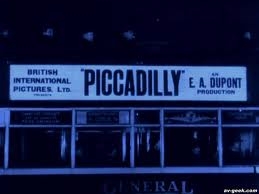
Our first view of Mabel is in an elaborate shawl and complicated head-dress emerging from a room marked ‘Private’. And a close up on a book of orchestrations marked ‘Mabel & Vic’ followed by a 180° move onto their performance in long shot, brings us into the tremendously textured, atmospheric world of the club, cutting to the dissatisfied customer and his plate, Wilmot unhappily watching proceedings in medium long shot from one staircase. The setting is a dynamic character in itself, which, in combination with the use of authentic location photography to establish space and locale, accentuates the plot patterns.
In this form and here in particular visual tropes are enhanced by the aesthetic choices of German cinematographer Werner Brandes whose inventive framing and frequent choice of tracking shots give the film a compelling sense of forward movement and excitement. 1929 was the year in which the genre (and in fact silent cinema in general) came to a kind of peak with Man With a Movie Camera (Vertov) after Berlin Symphony of a City (Ruttman, 1927) had created such an impact. It was a momentous achievement in the evolution of the European avant-garde. Piccadilly was not the first British production to take advantage of German cinematic genius but it was probably the most cosmopolitan.
Much cinema of this era could be classified as melodrama, a mode whose social function would have appealed to Bennett, a novelist acclaimed for his understanding of class and society. As a literary figure he was one of many lured to the studios and following a move by Sam Goldwyn to place emphasis on screenwriting rather than stars, Bennett (along with other luminaries such as Somerset Maugham) was hired by his former colleagues Adolph Zukor and Jesse Lasky to write for motion pictures. The 1921 film Sacred and Profane Love (William Desmond Taylor) was culled from his novel, THE BOOK OF CARLOTTA, (Stempel, 1991: 52). Directors were not universally admired however as screenwriter Anita Loos candidly admitted: “The directors were dunces, you know. [But] if you’ve got a good writer, the director has got the whole thing in his pocket” (McReadie, 1994: 3).
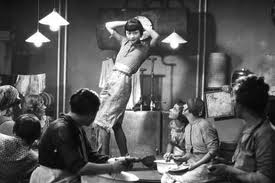
Shosho shimmies in the scullery
The screenplay as a form –or photoplay as it was known in this era– had developed in conjunction with D.W. Griffith’s technique of pictorial narration. (Ramsaye, 1964: 512)
During this period, Jacobs observes that,
The technique of screen writing itself … developed rapidly during these years, becoming more formalized and distinct from the literary and stage techniques. Screen writers became aware that above all it is necessary to think in terms of action, not description or dialogue: that the camera is the paramount consideration (Jacobs, 1967: 203; 218).
With the system of supervision initiated by Thomas Ince, the ‘shooting script’ became the order of the day while the increasing length of films necessitated the use of subtitles with the result that the writer’s fame was “almost on a par with the star and the director,” while the studio recognised that “a good scenarist, rather than a good author, was perhaps the greatest asset… It was presently realized… that the best results were obtained when the director and scenarist worked together,” a system apparently devised by June Mathis, who “proved that the carefully prepared shooting script was essential to good results in an art that was becoming more and more a collective project” (Jacobs: 219; 326-328). Edward Azlant’s comprehensive overview of American screenwriting from its earliest days to the 1920s indicates that as the studio system came about,
written design was by its very written nature procedurally distinct from other aspects of production. Thus, in addition to the intrinsic factors of the narrative mode itself
and the increasing length of films, the extrinsic factors of large-scale production and the evolving studio system surely helped institutionalise screenwriting (Azlant, 1980 : 85).
Starring the infamous Chinese-American actress Anna May Wong as Shosho, the bewitching Oriental dancer who performs at the titular club, she had been brought up in Los Angeles and made several appearances in Hollywood films, mostly in small showy roles as flower girls, or occasionally dragon ladies. Her role in Toll of the Sea (Franklin, 1922), scripted by Frances Marion, was notable for a number of reasons: it was the first production shot in two-strip Technicolor; and it brought her to the attention of Douglas Fairbanks, who cast her in The Thief of Baghdad (Walsh, 1924) which brought her scene-stealing talents to a huge audience. Like other Chinese American actresses of the era, Wong was often unhappy at her lack of opportunity and departed for Europe in 1928, appearing in a number of films made in Berlin and Britain. Piccadilly was one of them. Our first view of Shosho is clearly meant to be Wilmot’s too –a wide shot as she kicks up her heels in a Western shimmy on the scullery counters and then a low angle pan down her laddered stockings brings us to her patent maryjanes. The panning shot continues along the mesmerised faces of the kitchen staff’s faces (all women) and back to Shosho’s shoes and up her boy-like body once more. Wilmot tells Bessie to give Shosho her marching orders. We then enter the transitional space of corridors from the kitchen area to Wilmot’s office and the depth of field in the shots is enhanced by the line of pendant lights receding into the background; in Mabel’s overdecorated changing room she reads The Stage newspaper and the camera pans to her high-heeled shoes as Victor inform her of his plan to go to Broadway and she rejects his offer to join him. A large photograph of Wilmot dominates her wall and we cut to her eating suggestively, then Victor leaves Mabel and visits Wilmot’s office, entering in shadow. The scene is set.
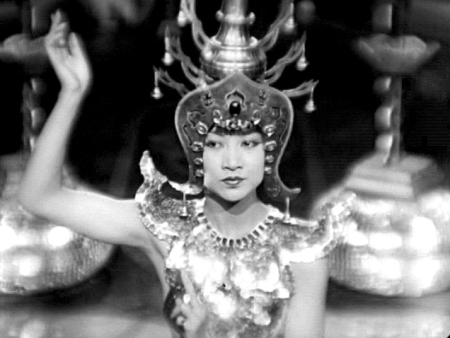
The spectacular £40 costume
Wilmot spots Mabel at the door, coyly hiding her face behind an evening clutch, with an enormous corsage on her coat, a beanie on her hair. She hides behind the fur muffs on her wrist as Victor’s exit from the club is effected, conveyed through a wide shot of the exterior with the bulbs flashing off on his name. The nightly clean-up begins, with the dance floor being swept (of Mabel, perhaps) and we cut to a low angle of shiny laddered tights and maryjanes walking carefully picking their steps down a spiral staircase when we see Shosho revealed, a snake belt visibly pulled across her short skirt. She is late because she says to Wilmot she is looking for her mascot. The camera pans back and forth from Wilmot’s pipe-smoking chauffeur as he takes in the scene between the pair and expresses shock when Wilmot follows her upstairs … This is the crux of the drama: the upstairs/downstairs divide. Outside, Bessie waits impatiently at a bus stop and when Shosho finally arrives the camera tracks on the bus and then inside as they move towards the East End, Shosho unperturbed and seemingly unmoved after her encounter with Wilmot. Back at Wilmot’s office a nodding Buddha totem rocks backwards and forwards on his desk and his accountant, Santos, expresses the belief that Victor’s departures “is a serious loss.” The camera pans left to right and back again to introduce dynamism into the shot, a typical move in the film’s visual strategy. Behind Wilmot is a framed photograph of Mabel on the wall, in a mirror image of the previous scene in her dressing room. Shosho eats at a café with Jim, and tells him she’s lost his mascot. He says “it’ll bring no luck to ‘im as finds it.” It is yet another foreshadowing of doom. Bessie summons her to Wilmot’s office, where she crosses her laddered-stockinged legs and Wilmot’s look is expressed in a panning shot from her shoes, and up those legs again. The camera cuts to her reaction shot, satisfyingly acknowledging his interest. And says she doesn’t mind trying the job of club performer. She says she had danced once in public before in Limehouse, but “They wouldn’t let me dance again, sir – there was trouble between two men – knives, policemen.” It is a warning but Wilmot doesn’t listen. He is busy sketching her face as Mabel enters the office he crumples up the work and throws it in a bin. Shosho stands up and is taller than Mabel in the shot, overwhelming her slighter figure: it is a sign in their shifting positions in the drama and with Wilmot. Her reaction shots to Mabel’s condescending remarks about Wilmot taking her back (into the scullery, following the plate incident) express contempt. Shosho tells Wilmot he should buy her Chinese costume in Limehouse, not one of those shops for Westerners in Soho. At the Chinese Restaurant on Causeway he is exposed to opium smokers and gamblers –the usual array of Oriental exotica to which one is inured. The proprietor’s nephew Jim models the fantastical head dress –while Shosho stands demurely beneath a sword beside a full-size warrior outfit, in an indication of the power shift in their own secret relationship.
At Wilmot’s office Mabel dances a toned-down version of the Seven Veils and sits in his lap as they play at amour. The tension is palpable and he prepares to surprise her with the ‘happy’ news that Shosho will be trying a real Chinese dance at the club. He grapples with sheet music, ‘When Love Comes Stealing.’ Mabel is convinced the crowds will laugh at Shosho: she is unaware they have already been mocking her. And her love has already been stolen by this stealth missile with her Western clothes, shimmying and Oriental style.
The master narrative is about artifice, sex and seduction, with a masochistic drive at its centre: Wilmot is lured by an Oriental siren to break away from the world of illusion and into reality as she experiences it – once there, a spiral of temptation and danger and violence is quickly unleashed and we are given a symbolic warning about the dangers of inter-racial sexual relations. We are taken on a travelogue of central London which boasts different levels of society and different races and expectations, strictures and stereotypes. Issues of colonialism and imperialism are implicit in any narrative of the time while xenophobia is never far from the surface in this socially conscious work; cultural malaise is implicit despite the overwhelming excitement of the city’s superficial attractions not to mention the freewheeling exotica on offer. The representation of ethnicity and coded foreignness dominate the dramatic action here. While the Orient is a shorthand for ‘evil’ and cunning in early cinema, as well as connoting decadence in all its forms – sex, drugs, excess, Wong is the classic femme fatale, a scullery maid turned exotic dancer who forces people into amoral drama by virtue of her appearance alone which however is rendered complex by her dress and penchant for the shimmy: she is more of a flapper than Mabel, her race notwithstanding. The inter-race relations which are deemed taboo are signified by the casting out of a white woman from a saloon bar in Limehouse for dancing with a black man. In the film’s casting alone, we have Wong (a Chinese-American) and Ziegfeld Follies star Gray (Polish-American, born Marianna Michalska in Warsaw, 1915). ‘Otherness’ and the associated (if perhaps symbolic sense of adventure) are central to the film’s play in terms of venality, ambition and the impenetrable mask that hides true nature (the Yellow Peril of legend). Neither woman could be said to be ‘good,’ in the sense that film noir might imply, given that both are essentially showgirls, and it is the fug of feminine allure and their polar attractions that poisons the atmosphere and leads Wilmot astray: however the punishment is not his to bear.
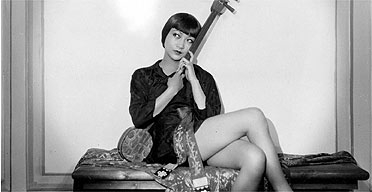
Wong in typically suggestive publicity pose
Shosho is obviously the more aggressive actor in the drama, occupying a world in which racial mixing is taboo. Generically we move from the backstage melodrama to a courtroom drama and it is only then that we find out following a brief dramatic ellipsis using newspaper headlines to inform us that it is in fact Shosho who has been murdered. A flashback, initiated by Jim’s suicide attempt, then reveals the true story: he is incensed by Shosho’s affair, he finds the pistol that Mabel brought to confront Shosho, and the quick dissolve (attributed to a female fainting spell and consequent amnesia) during the women’s confrontation is finally revealed to have been a moment of dramatic licence, permitting this traditional storytelling to create a twist at the end our suspended disbelief
The theme of the film is projected in the essence of the dramatic action which could even be described as film noir, if we understand that to be a crime or mystery drama with a group of distinctive visual elements, one in which Schrader says self-doubt is submerged in mannerism and style: “ …in such a world style becomes paramount; it is all that separates one from meaninglessness.” (Schrader, 1972: 8-13). The style is intrinsic to the expression of the story’s concerns, contrasting the shimmering luminosity of the Piccadilly Club with the darker exotic corners of Limehouse, linked by the public transport system that introduces the city to us in the title sequence, an internationally famous location coated with a phosphorescent neon glow of modernity. Bennett was very familiar with the setting – he lived in the city at a variety of locations throughout his adult life in the environs of Oxford Street, Hanover Square and Cadogan Square. His frequent forays to the Savoy even led the chef to create an omelette dish in his honour. He was a journalist and a man about town who had co-habited with an actress following a separation from his wife in the early 20s; he was acclaimed in his lifetime even if he wasn’t a favourite with the Bloomsbury set and was by this time a tastemaker critic. Therefore it was quite a coup to attract him to BIP in order to write an original, contemporary work for the screen. It was in fact his last major piece of writing –he was to die two years later of typhoid.
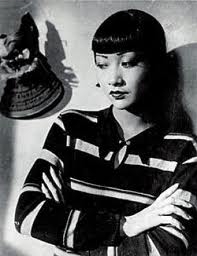
Thoroughly Modern Shosho
Let us remind ourselves of James Monaco’s assertion, that “… myth and reality are closely interconnected. Real myths, those artistic evidences of our collective unconscious, spring directly from roots in reality, they heighten reality and condense it” (Monaco, 1979: 251). The film is organised in a number of movements which lead inexorably to a cataclysmic incident of violence characterised by transgression – social, sexual, racial. All of these issues have their relationship with the myth of total female performance –in public and private. Mabel’s feeble array of sexually paraphernalia are as nothing compared with the simplicity of Shosho’s exotic appeal with her clean lines, sleek legs and straightforward carnality.
The construction of scene sequences is one of the ways in which films manage both information, thematic content and momentum. It was an explicit part of the early cinema’s screenwriting process, with sequences identified on screenplays. As a creative tool it enables the screenwriter to focus the action on a narrow vein of the overall controlling narrative but maintaining strict attention on the particular section of dramatic action. From a purely practical perspective, sequences were timed to last a reel of film (c. 10-15 minutes) and therefore provided a simple way in which to divide the action as well as to control certain aspects of production for which of course the screen–or photoplay– was specifically designed as template (Heyes, 2012). Nowadays it is less recognised as a structuring tool but can involve lengthier scenes of complexity revolving around not just dramatic action and its elliptical organisation but perhaps centre around a fetish object or minor character or subplot. A film’s midpoint sequence (literally leading up to and after the middle of the narrative) regularly sums up a film’s central concerns –dramatically and thematically– and can serve as a model for the film narrative as a whole.
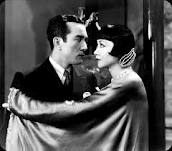
Enveloped by the seductress
The midpoint sequence in Piccadilly takes us to Limehouse in the East End and back to Piccadilly and therefore is a microcosm of the film’s overall effect: Wilmot approaches Shosho and agrees to pay £40 for the elaborate lamé headpiece and cut-out costume which will literally cut a swathe through Mabel’s more conventional showgirl outfit with its frou-frou feathers and head-dress. Shosho’s semaphore with Jim indicates that they are setting Wilmot up and she insists that he play the music for her performances at the club. She is framed beneath a Chinese sword –a portent of things to come. This is typical of the film’s narrative and visual scheme: foreshadowing in order to pay off later. We then cut to her first night at the Piccadilly. Shosho’s angular Oriental-style movements amidst four twirling mirror balls entrances the audience. She is exhibited in a shimmer of metallic reflections. We cut from this wide shot to Mabel’s stricken look in mid-shot on the sidelines of the stage floor and back to Shosho’s shadow dance with the dancing reflections from the mirror balls thrown back across the audience. Her shadowy, jagged movements call up memories of another shadowy, threatening figure in Nosferatu (Murnau, 1922), lurching up a staircase to his victim.
The club audience is always at eye-level, forcing us to acknowledge our role in the construction of the patterns of looking. Shosho’s arms and her slight choreographed motions have a very different effect from Mabel’s lively, unhinged showstoppers. Bessie rushes from behind a ‘Staff Only’ door to clap her appreciation. When Wilmot goes to announce to Mabel that Shosho is a hit, he finds her, collapsed in a mess of feathers, on the floor of her dressing room.
The scene sequence that follows the midpoint centres around shoes and feet – Shosho stretches on her bed, gets out and folds her feet into Chinese slippers to read the newspaper headline, “Shosho the dancing wonder,” and exchanges looks of what we assume to be shared connubial bliss with him. She covers his head with the newspaper and steals a kiss behind the headlines. She pins the newspaper onto the wall and a close-up on the headline transitions into the same headline being read by Mabel, who is wearing high-heeled sandals in her dressing room. A maid brings in an enormous arched flower arrangement with a note which in close up reads “To Miss Mabel, A thought from one who was in the kitchen.” Bessie informs Mabel of Shosho’s private dance for Wilmot and Mabel looks stricken once again.
The controlling focus of the male gaze is called into question by the context and the repeated reaction shots of women in the club’s audience who are visibly underwhelmed first by Mabel’s efforts and then by the strangeness of Shosho’s first night presentation: one in particular (with a monocle) speaks throughout Shosho’s display. We are constantly reminded of the critical function of looking (and judging). It may well be that the male is the more passive and gullible spectator and Wilmot’s behaviour enacts a structured masochistic response, which is transposed into three separate social strata, thereby relocating the viewer’s spectator position. We might reasonably expect in the male masochistic narrative that it is he who will be punished: however this narrative scheme is jettisoned in favour of reaffirming the film’s ideology. If Shosho’s eruption into the narrative destabilises the relationships, her existence also anchors the story’s direction and gives it balance. She forces the re-mapping of the story elements, catalysing Wilmot’s decision-making process, sadistically forcing Mabel into even more demeaning situations (we know from the idle chatter of the London club crowd that she is Wilmot’s mistress); and taking the action that will create the mode for her own social transformation.
The distance between the actors is measured not merely in terms of physical space but in two equally significant ways – the one being racial; the other, social. ‘Staff Only’ signs decorate several shots; the demarcation of strata is another way in which both dramatic action and function are delineated. It is not excessive to read the film in this way because it is not so much an arbitrary interpretative scheme as an artistic construct which is crystallised in a midshot of Jim in the aftermath of Shosho’s departure with Wilmot in a limousine having signed his contract: Jim is left bereft outside the Club, at a door marked ‘Staff Only.’ He has earlier found the nodding Buddha totem he gave Shosho on Wilmot’s desk and the penny has dropped that she is now with her employer. The shot is a metonym for the narrative action as a whole, lines that should not be crossed are clearly demarcated and Shosho dramatically shuts a door on him in order to show him how things are. He is ghettoised. The film stresses how much simpler it is for women to move up the social ladder, but equally, how compromising.
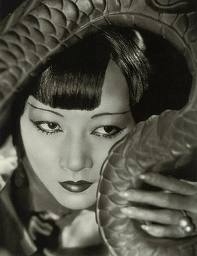
Serpentine sensuality
Narrative suspense is withheld only insofar as the genre permits the parsing out of information in a dramatic fashion; the relationship between Wilmot and Mabel is threatened by his decision to hire Shosho as the alternative entertainment in the club after Victor Smiles has quit and the audience clearly thinks Mabel too old for her role, an accusation that then becomes personalised and repeated in a different context when she confronts Shosho and the younger woman says Mabel is too old for Wilmot, too; the relationship between Shosho and Jim and its severance by her contract with Wilmot serves as the basis of the other source of tension. So Shosho is the apex of these shifting triangular relationships, with Mabel and Victor serving as the other public ‘couple’ whose success is now rivalled by Shosho’s discovery as a dancing wonder with Mabel’s ultimate (and public) dependence on Wilmot the crux of the drama, the obverse to Shosho’s seductive domination and feline control. The two female protagonists offer us alternating views on the potential models of femininity, neither of which is either stable or passive. The symbolism offered by the spiral staircase, offering us a gloss on the upstairs/downstairs class structure, and an opportunity for Shosho to ascend to Wilmot’s office, and for him to live at her level, is glaringly obvious but cunningly used. We see Shosho descend, feet first, in her modern getup, short skirt and striper; we see Wilmot follow her up and she gives him an unseen private dance, leaving her mascot behind her; and the second descent sees her clad in expensive couture, a cloche hat concealing her bobbed hair, fur collar and cuffs emphasising her journey from scullerymaid to proprietor’s mistress. Her movements up and down the staircase are sinuous and insinuating, an active metaphor for the price one pays for social mobility.
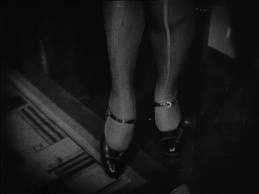
Laddered stockings and patent maryjanes
The film’s tone is located in its settings and its balance of characters and how the drama is eventually resolved. London’s Limehouse becomes a cinematic space of intrigue, a mostly imaginary locale in which racial fears are realised in an urban setting. The suburban fear of immigration –for which this area of London was a mecca throughout the preceding two centuries– is enacted in this source of textual richness. It is posited against the more civilised (that is, whiter) environs of the West End wherein the more specifically ‘English’ identity with its veneer of civility is constructed (Newland, 2008). However this is always a film about the pleasure of looking (scopophilia). The enjoyment of the ordinary folk in the saloon bar and their visceral dancing style beneath the glare of the lights is contrasted with the artifice of the performance style evidenced in the club. This is more clearly sexualised and physical, without the staging and acknowledgement of falsehood. Notions of performativity are communicated by Shosho’s decision to physically withdraw into a crowd; when Wilmot touches her to leave, her back is to camera. The public sphere is offered another kind of definition here, one in which appearance and reality converge and even she is loath to acknowledge it. The myth of performance exists to translate codes which dominate the narrative of existence –and survival.
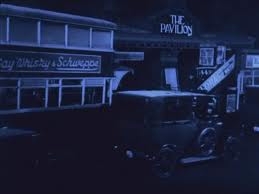
The signage-bedecked bus fleet
We might say the city is a locus of liminality (or even of evolution in a kind of reverse mode), a place of transition in which nothing and nobody is quite what they seem. Movement from one locale to another involves the donning of masks and performance is the equaliser between strata. The illusion is all. The city’s position as place of transition is noted in the title sequence in which public transport efficiently effects geographic alteration and psychological transition. The audience is imparted a sense of incompleteness and even misrecognition with the shifts in location which connote different or perhaps opposing value systems and codes in this liminal landscape. Thus the film’s preoccupation with identity –a modern phenomenon of psychology– and modernity, itself concerned with issues social, physical and emotional, are conjoined in a narrative that traverses postcode districts, mobility, migration, and the spaces in between, shaped by a distinctive geography that has at its centre the familiar postcard image of the centre of the world’s most famous city, its busy, buzzing, throbbing heart.
The urban space is the locus of interrogation: it is the site of the importation of cultural values and ideological impetus, filtered through the medium of familiar generic narrative ostensibly produced as entertainment. Genre exists to reinforce ideology through ritual, usually in order to convey in a narrative sense the threat introduced to stability by minority groups and women –here they are both embodied in the figure of Shosho, a determinedly modern Eastern (and East End) woman whose only concession to the Orient in her dress is at Wilmot’s request in her public performance on the dancefloor. Costumes can function as marks of authenticity, character props or description, an extension of the character with stylistic and dramatic functions. Here, Shosho’s clean, shiny, modern lines are in stark contrast with the elaborate Nouveau couture which Mabel sports with her blanched makeup. When Shosho earns her first pay packet she descends the spiral staircase in a more tasteful fur-cuffed coat than the extravagant concoction we have seen Mabel wearing; when she appears from behind a beaded curtain to have Wilmot button her up in a black jacket and cape she resembles a sleek black insect with her cloche hat concealing her bob. It is clear that she is portraying a predator.
The array of fetish objects in the film is ultimately identified within the realm of the dance scenes –Mabel’s showgirl costumes and elaborate dresses and coats; Shosho’s starkly revealing cut-out costumes; the women’s faces and their contrasting makeup for white and Oriental skin tones; dancing shoes and Chinese slippers, feet clad in high heels and maryjanes; the glass partitions in Shosho’s rooms which have etched paintings of dragons and other Oriental signifiers opposed to the more overtly feminine Nouveau style of Mabel’s dressing room; the performance space offered by the club opposed to the liberating public space offered by the drunken smoky overlit bar. Sex and violence are necessarily conjoined in the film’s emotional and dramatic geometry: Shosho’s appearance and costume connote foreignness (albeit a very sharply modern, unfussy, Chanel-esque kind) and her guile and cunning are cast against Mabel’s more traditional femininity, feathers and frou-frou fussiness. Both are ultimately drawn to violence, ensnared in the other’s web. One scene introduces their balanced position in a two-shot and hence the narrative gives them equal space if unequal dramatic importance. Both wear veils at crucial points in the story. They mirror one another: both are urban, eroticised females whose appearance is an illusion and whose life is centred on performance, both in public and private spaces, performance which is dependent on sexualised movement, opposed, re-played and contrasted in every scene, hastened in the film’s second overall movement.
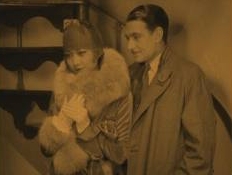
Descending the spiral staircase the second time
The film’s central dramatic conflict thus centres on space and on place – and knowing one’s place in the world. The drama turns upon the recognition of boundaries and the possibility that in a city one might cross those lines and become a success but also that its obverse, social misrecognition, could lead to something unfitting or worse. Locating the source of the crime within the Asian community is essential to the film’s politics, which of course are intrinsically reflective of the time in which it was made. It might be described as burlesque, a term significant inasmuch as it is a twofold technique, the “breaking of convention by the intrusion of reality and the inversion of expected implications,” and intended to comment on conventional genres, a tradition which dates to Aristophanes (Cawelti, 1992: 506) .
Effectively the film re-starts 73 minutes in: the title card, ‘New Piccadilly Nights’ introduces this second movement in the drama and it is clear that Wilmot is re-living his life, a different way, more swiftly, with the repetition of previous incidents and scenes which now have startling outcomes and repercussions in their different context. It is a very smart way to construct a screenplay and a very clever means of impelling dramatic action, allowing the protagonist (and vicariously, the audience, for which he is a channel) to pursue the ‘what if…’ line in indulging the lure of temptation, vice and taboo. Doormen now pull the safety barrier across the club’s entrance and Wilmot descends the spiral staircase, for the second time in the film, while Shosho joins him, dressed to the nines. Cut to close ups of drinks lined up at a bar, served to punters’ hands, utterly depersonalised and anonymous until we get to the recognisable dagger-like nails which are handed a drink by Wilmot’s manicured hands. We are, then, transported fully into the sphere of transgression: a saloon bar in the East End where the dancing is part of everyday experience, the races commingle (or attempt to do so), fantasy and sexual desire converge with spectacle and the policemen look in the windows but otherwise give it a wide berth. It is part of the film’s over-determination that we are now presented with a different level of the social hierarchy. Wilmot has now entered Shosho’s world, delineated by symbolic arches, another form of internal framing, which is so crucial to the film’s mise en scène. The rules are different.
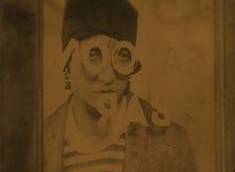
A film du look
The imaginative use of props introduces a new woman into the general melée of which Wilmot and Shosho operate as mere observers – her eyes are bespectacled by the O’s in the word ‘saloon’ printed on the door as she scopes out the joint: this is a film which constantly articulates scopophilia. She has the gall to agree to a dance with a black man and the proprietor (in a Dennis the Menace shirt) breaks it up as she should know she can’t be seen with him, according to the title: “Are you blind or wot?” It is a nod to our initial introduction to her through the window pane and a preview of coming attractions, the drama’s conflict of looking, in microcosm. One shot conjures up a vision of life through a drunkard’s glass, distorted and lively. We note that Shosho is performing here too, now shying away from the public: this is an extension of her stage performance and her ‘show’ with Jim in front of the crowd, the public are not the wealthy punters at the Piccadilly Club. This is the difference between a community of which she is a part and an alien audience in front of whom she is the vessel for lustful desire. Her life is a canny interpretation of what Wilmot wants – his desire for sexualised spectacle is the excess that destabilises the social order. She is here physically withdrawing from the ‘ordinary’ East Enders whose desire is on display; hers is more secretive and furtive, to take place behind closed doors. She turns her back on the scene as Wilmot insists they leave: her performativity has altered its register, in tandem with her attire.
The conscious presentation of female sexuality within the club is contrasted with the spectacle of real life, “our Piccadilly,” as Shosho tells Wilmot. The scene operates as a representation of the dramatic action – the danger in breaking taboos. The coda is introduced simply, as a break in the geographic space through arches shrouded in London fog and the smoke from street braziers, fizzing with moral murk. Modernity requires navigational skills, particularly when it involves social transformation. Shosho mutates from charming girl to ambitious siren and carnal mistress in the time it takes to travel from Limehouse to Piccadilly by bus, or bursting through a door marked ‘Staff Only’ onto a dancefloor.
Shosho and Wilmot exit and walk to an archway where a beer lorry marked ‘Limehouse’ passes them and they vanish in another of Dupont’s magical shot transitions after Shosho hands him a key. Behind them the pasted newspaper headlines inform us of ‘London Fire Scenes.’ We then see Shosho and Wilmot in her new rooms, partitioned with glass etchings of dragons and Buddhist figures. For a brief moment Shosho has a moustache conferred upon her by the wavy line on a drawing etched on glass. She is framed by a maze of dragon illustrations and ornate screens, whilst outside a shadow, reminding us of the shadows that Shosho created on the Piccadilly’s floor, looks up, a female silhouette, as Shosho reclines invitingly, a veiled shawl draped, half-covering her face as Wilmot inches forward… and the shadow outside finally disappears, understanding the nature of the exchange. Shosho and Wilmot are consumed by one another. The saloon bar thus serves as the locus of slippage; the lorry marked ‘Limehouse’ is the vehicle which literally transports Valentine through a passage and into the underworld of Shosho and the East End. We have now entered the domain for which all these signs accumulate to warn us, Keep Out. The inter-racial kiss which was written by Bennett and was in fact shot, was censored and never seen. However its existence (and a lot more besides) is easily inferred by the editing: illusion is all. At the doorway, Wilmot pays Jim. And Mabel’s shadow becomes real and she returns in actuality, permitting her to enter the building.
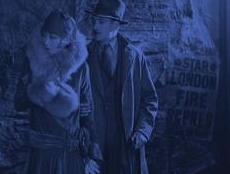
“Underneath the arches …”
Here, at last, the women properly confront each other, with no witnesses. Mabel’s face is half-veiled and they are finally permitted a two-shot in which they occupy equal space: Shosho no longer towers over her love rival: they now occupy equal dramatic space too. The camera pans left to right from one to the other then tracks out to a midshot of them. There is then a series of alternating medium close ups and two shots, with a lower angle on Shosho as she turns down Mabel’s offer of a cigarette because she doesn’t in fact smoke. Mabel is surrounded by wisping clouds and Shosho hurriedly dumps evidence of Wilmot’s recent visit – an overflowing ashtray. It is a replay of what Wilmot did when Mabel entered his office after he hired Shosho to be her replacement. She taps her fingers nervously on her shoulder and Mabel pleads with her to leave Wilmot because he’s too old for Shosho. Shosho rebuts her request and says that Mabel is too old for him. Mabel remains seated while Shosho shouts, “I want him … and I shall keep him.” She pulls a draped sleeve over her face and a dagger from the wall, Mabel fumbles in her handbag and finds a pistol. She then appears to pull the trigger and falls away into a clean faint. Newspaper boards then tell us after a brief ellipsis with misleading headlines, that “Shosho the Chinese Dancer [is] Found Dead.” We have no clear idea as to what has happened between the women.
In the film’s final section, Mabel is transformed once again from an active persona into a passive specular position with which the viewer ultimately empathizes –she has been abandoned by both the men in her life– and this is confirmed in the narrative’s construction when the facts are laid bare by due process in the courtroom scenes which dominate the film’s final movement. Mabel hides herself and, clad in dark clothing, draping her face, trying to remain in shadow despite the stark lighting of open court and the benches, becomes a clearly sympathetic character despite our suspicions that she may have killed Shosho in the fit of jealous rage which we witnessed. However her appearance, outnumbered by men, white as well as Chinese, encourages our doubt. Our position of knowledge is now challenged and (literally) re-Oriented and our fear of foreign-ness justified with the discovery in a flashback (Jim’s confession) that Mabel did not in fact shoot Shosho, Jim did. Both Oriental figures in the film’s shifting triangular relationships have now been eliminated. The film’s conclusion marks a return to stability: a man wearing a sandwich board advertises a show called ‘Life Goes on’ and a small but significant camera movement from right to left returns us to Piccadilly Circus in a re-enactment of the opening scene, on the flashing neon lights of theatres and clubland, a hub of international influences meeting and colliding with variable outcomes – rather like the story itself, which ultimately seeks to disavow the linking of the fantasy with the real, despite the spectacle’s obvious allure: look, but don’t touch.
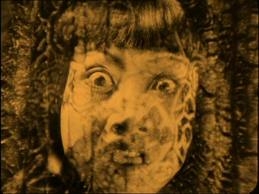
Daggers drawn and silent shrieks
Contemporary reviews were overwhelmingly favourable in an American context:
“Wonder of wonders –a truly fine British picture! Gilda Gray is starred, but Anna May Wong brings home the bacon.” Photoplay, October, 1929.
“A good picture that in the silent days could have made the deluxe first runs over here with its Gilda Gray name. It is virtually silent despite a useless prologue. It may have been added and contains its only dialog, badly done. In present silent houses ‘??Piccadilly??’ is okay for a week or a day, this due to Miss Gray’s name, the story and Anna May Wong, who outshines the star” Variety, July 24, 1929.
“Miss Gray seems to have been rediscovered as an actress. For a long time she has been docketed as an exponent of ‘shimmy,’ but in Piccadilly she appears to show that acting is not above her” The New York Times, July 14, 1929. (www.silentsaregolden.com)
However, as usual, the local critics were not quite so kind, with Hugh Castle writing in Close-Up that Piccadilly was “a typical British film” and therefore, “one of the world’s worst” (Sweet, 2005). Contemporary critics are much kinder however and as one puts it, the film has “Pabst out-Pabsted.” (Coniam, 2009). This is a reminder that 1928 produced Pandora’s Box (Pabst) with another Hollywood emigrée, that other thoroughly modern girl, Louise Brooks. However the power of Piccadilly is not merely its expressionism or its indelible central performance by Wong, but its conjunction of these with social commentary in a melodramatic, commercial story.
The film’s original running time of 92 minutes was extended by 16 minutes for the restoration which was released in the UK in 2004. The film’s tinted and toned print with a new score by jazz composer Neil Brand led the viewer to re-visit a crucial time in British cinema history, when the industry embraced Expressionist technique and conjoined it with socially conscious writing, exposing a slice of cosmopolitan London life which operated on operatic scale in the international style. Hitchcock may have been the most ambitious and irritating director on the scene but Piccadilly proved that at executive level there was a conscious effort being made to bring the European art house sensibility and aesthetic into the commercial world of Hollywood-dominated British exhibition.
Dupont would make another film for BIP, the Titanic drama, Atlantic (1929), a film which has a typically innovative approach to the new sound technology as well as boasting multiple language versions, a fad which was created to overcome issues with audiences following the transition from silents. He stayed in Britain for another while, completing two more films for BIP (Two Worlds??,1930; ??Cape Forlorn, 1931). He would return for a spell to Germany but left after Hitler’s rise to power, before finishing his days making B pictures in Hollywood where he died in 1956. Ultimately Anna May Wong would be immortalised under Josef von Sternberg’s direction in Shanghai Express (1932). For now, though, she was a cult icon in a London city film, a backstage cross-class murder-mystery about love, seduction, eroticism, sexual taboo, transgression and death – the little things in life. Ascending the social order involves more than just a bus ride across town and masochistic narratives must have their victims. It was Wong’s greatest performance. As Dorothy Parker put it, more or less, not a single story ever had a happy ending. But in the meantime we have Piccadilly. It is a thrilling parade.
Bibliography
BooksBarrow, Sarah and John White (eds.) (2008). FIFTY KEY BRITISH FILMS. London: Routledge.
Bordwell, David, Janet Staiger, and Kristin Thompson (1994). THE CLASSICAL HOLLYWOOD CINEMA: Film Style and Mode of Production to 1960. London: Routledge.
________ and Kristin Thompson (1997). FILM ART: An Introduction. New York: McGraw-Hill.
Cawelti, John G. (1992),‘CHINATOWN and Generic Transformation in Recent American Films,’ in FILM THEORY AND CRITICISM: Introductory Readings (4th ed.) edited by Gerald Mast, Marshall Cohen and Leo Braudy. Oxford and New York: Oxford University Press.
Cook, Pam (ed.) (1990). THE CINEMA BOOK. London: BFI Publishing.
Dickinson, Margaret and Sarah Street (2003). CINEMA AND THE STATE: The Film Industry and the British Government 1927-84. .London: BFI Publishing.
Gledhill Christine ‘Late Silent Cinema, ‘ in Murphy (2008), 163-176.
Gulino, Paul Joseph (2004). SCREENWRITING: The Sequence Approach: The Hidden Structure of Successful Screenplays. New York: Continuum.
Jacobs, Lewis (1967). THE RISE OF THE AMERICAN FILM: A Critical History. New York: Teachers College Press.
Kreimeier, Klaus (1999). THE UFA STORY: A History of Germany’s Greatest Film Company, 1918-1945 (Weimar Now: German Cultural Criticism). Berkeley: University of California Press.
Marchetti, Gina (1995). ROMANCE AND THE YELLOW PERIL: Race, Sex and Discursive Strategies in Hollywood Fiction. Berkeley: University of California Press.
McCreadie, Marsha (1994). THE WOMEN WHO WRITE THE MOVIES: From Frances Marion to Nora Ephron. New York: Birch Lane Press.
Monaco, James (1979). AMERICAN FILM NOW. New York, Plume Books.
Murphy, Robert (2008). THE BRITISH CINEMA BOOK (3rd ed.) London: Palgrave MacMillan.
Newland, Paul (2008). THE CULTURAL CONSTRUCTION OF LONDON’S EAST END: Urban Iconography, Modernity and the Spatialness of Englishness. New York: Rodopi.
Pye, John (ed.). (2008). TIME OUT FILM GUIDE. London: Ebury Publishing.
Street, Sarah (2008). ‘British Film and the National Interest, 1927-39,’ in Murphy (2008), 185-191.
Ramsaye, Terry (1964). A MILLION AND ONE NIGHTS: A History of the Motion Picture. New York: Simon & Schuster, 1926; rept. London: Frank Cass & Co. Ltd.
Said, Edward (1978). ORIENTALISM. New York, Pantheon Books.
Stempel, Tom (1991). FRAMEWORK: A History of Screenwriting in the American Film. New York: Continuum.
Thompson, Kristin and David Bordwell (1994). FILM HISTORY: An Introduction. New York: McGraw-Hill Inc.
Journals/ArticlesConiam, Matthew (2009). ‘Piccadilly (1929): Pabst Out-Pabsted … and a New Look for the Old Phoenix,’ Movietone.
Doromal, Krystle (2007) ‘From Yellow Peril to Yellow Fever – The Representation of Asians from Anna May Wong to Lucy Liu,’ Offscreen, May 2007 (11) 5. Accessed 12 August 2012
Heyes, Melvyn P. (2012). ‘Development of a Fundamental 19-Sequence Model of Screenplay and Film Narrative Structure,’ Journal of Screenwriting, Vol.3, Issue 2, 2012: 217-238. Accessed 07 November 2012.
Kapczynski, Jennifer (2010.) ‘Still Motion Dance and Stasis in the Weimar Operetta Film, in Seminar: A Journal of Germanic Studies, Vol. 46, No. 3, September 2010. Accessed 11 November 2012.
Leong, Karen (2006). ‘Anna May Wong and the British Film Industry,’ Quarterly Review of Film and Video, Vol. 23, No. 1, January-March 2006: 13-22.
Lim, Shirley Jennifer (2012). ‘ “Speaking German Like Nobody’s Business”. Anna May Wong, Walter Benjamin, and the Possibilities of Asian American Cosmopolitanism,’ Journal of Transnational American Studies, Vol. 4, No. 1. Accessed 12 November 2012.
Mulvey, Laura (1975). ‘Visual Pleasure and Narrative Cinema,’ Screen, Vol.16, No.3: 6-18.
Schrader, Paul (1972). ‘Notes on Film Noir,’ Film Comment, Vol. 8, No. 1, Spring 1972.
Silents are Golden. Accessed 12 August 2012.
Street, Sarah (2008) ‘Extending Frames and Exploring Space: Alfred Junge, Set Design and Genre in British Cinema,’ DESTINATION LONDON: 100-110.
Sweet, Matthew (2005). ‘Stick Up for Brit Flicks,’ 04 February 2005, Accessed 12 August 2012.
________ (2008).‘Snakes, Slaves and Seduction,’ The Guardian, 06 February 2008. Accessed 12 August 2012.
Wang, Yiman (2005). ‘The Art of Screen Passing: Anna May Wong’s Yellow Yellowface Performance in the Art Deco Era,’ Camera Obscura (20) 3: 159-90. Accessed 12 August 2012.
Worrell, Joseph (2003), ‘On the Dragon Lady’s Trail: Rediscovering the Films and Image of Anna May Wong in Classical Hollywood Cinema,’ Asian Cinema 2,May 2003: 3-34. Accessed 12 August 2012.
________ (2008). ‘Anna May Wong,’ www.silentera.com. Accessed 07 November 2012.
DissertationsAzlant, Edward P. (1980). THE THEORY, HISTORY AND PRACTICE OF SCREENWRITING 1897-1920. (Unpublished doctoral dissertation at University of Wisconsin)
Online resources
Kristin Thompson and Kevin B.Lee Shooting Down Pictures video essay on E.A. Dupont’s Variety
FilmographyAtlantic (1929) Dir: E.A. Dupont (British International Pictures)
Piccadilly (1929) Dir: E.A. Dupont (British International Pictures)
Shanghai Express (1932) Dir: Josef von Sternberg (Paramount Pictures)
Variety (1925) Dir: E.A. Dupont (Ufa)
All images copyright Studio Canal.

